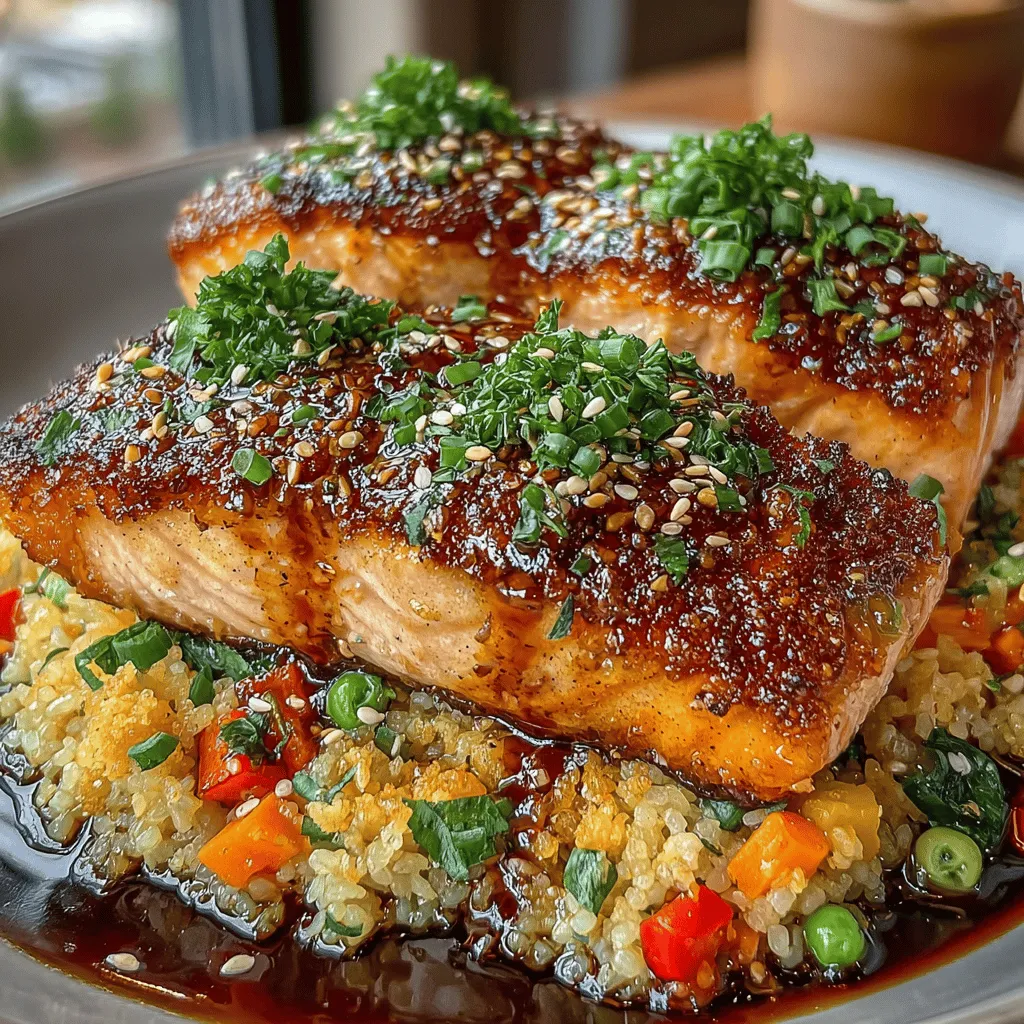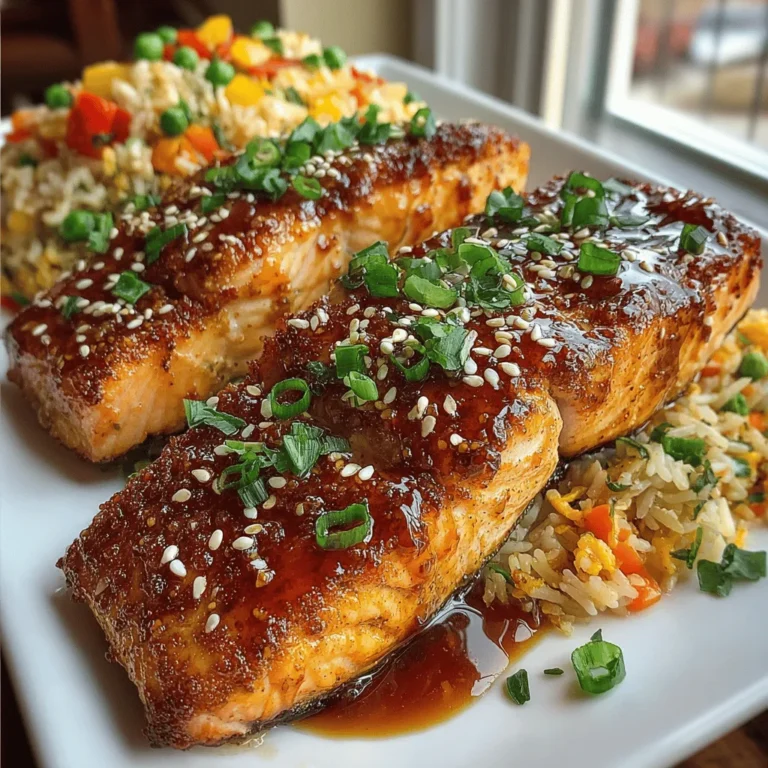In today’s fast-paced world, where time often feels like a luxury, finding the balance between a healthy diet and convenience is essential. Enter “Savory Teriyaki Delight: Quick Teriyaki Salmon with Veggie Rice.” This delectable dish combines the rich, umami flavors of teriyaki salmon with a colorful medley of veggie rice, making it not only a feast for the palate but also a nourishing option for busy individuals and families.
The beauty of this recipe lies in its simplicity and speed—perfect for weeknight dinners or when you want to impress guests without spending hours in the kitchen. With just a few ingredients and minimal prep time, you can create a meal that is both satisfying and wholesome.
Understanding Teriyaki: A Flavorful Tradition
What is Teriyaki?
Teriyaki is a traditional Japanese cooking technique that involves grilling or broiling meat or fish after marinating it in a flavorful sauce. The term “teriyaki” translates to “glaze” or “shiny broil,” which perfectly encapsulates the final presentation of the dish. The key to teriyaki is its sauce, which is typically made from soy sauce, sake, mirin, and sugar. This combination creates a sticky, sweet, and savory glaze that enhances the natural flavors of the protein being cooked.
The versatility of teriyaki makes it a popular choice beyond just fish; it can also be used with chicken, beef, or vegetables, allowing home cooks to explore a range of culinary options.
Health Benefits of Teriyaki Sauce
The ingredients that define teriyaki sauce not only contribute to its unforgettable taste but also offer a variety of health benefits. Soy sauce, for example, is a source of plant-based protein and contains antioxidants. When made at home, teriyaki sauce allows for greater control over sugar and sodium levels, making it a healthier alternative to many store-bought versions, which often contain preservatives and additives. Homemade teriyaki sauce can be tailored to suit dietary preferences, whether you’re looking to reduce sugar or incorporate more natural ingredients.
The Star of the Dish: Salmon
Nutritional Benefits of Salmon
Salmon is often celebrated as a superfood, and for good reason. This fatty fish is rich in omega-3 fatty acids, which are essential for heart health and cognitive function. Omega-3s help reduce inflammation in the body and are linked to a lower risk of chronic diseases. Additionally, salmon is an excellent source of high-quality protein, providing the necessary building blocks for muscle repair and growth.
Incorporating salmon into your diet can also offer a range of vitamins and minerals, including B vitamins, selenium, and potassium. These nutrients contribute to overall well-being, making salmon a stellar choice for a nutritious meal.
Sourcing Quality Salmon
When preparing teriyaki salmon, the quality of the fish can significantly impact the final dish. Here are a few tips for sourcing fresh salmon fillets:
1. Look for color and texture: Fresh salmon should have a vibrant color, ranging from deep pink to orange, and should feel firm to the touch. Avoid fillets that appear dull or have brown spots.
2. Check for sustainability: Choosing sustainably sourced salmon not only helps protect fish populations but also ensures that you are consuming a healthier product. Look for labels such as “wild-caught” or certifications from organizations like the Marine Stewardship Council (MSC).
3. Ask your fishmonger: Don’t hesitate to ask questions at your local fish market or grocery store. A knowledgeable fishmonger can guide you in selecting the freshest options available.
Veggie Rice: A Colorful Sidekick
Choosing the Right Rice
When it comes to pairing with teriyaki salmon, rice serves as the perfect base. The choice of rice can elevate your dish, and two popular options are jasmine and basmati rice. Jasmine rice, with its slightly sticky texture and floral aroma, complements the sweet and savory notes of teriyaki beautifully. On the other hand, basmati rice, known for its long grains and nutty flavor, provides a more aromatic and fluffy texture.
Both types of rice are versatile and can absorb the flavors of the dish, making them ideal companions for your teriyaki salmon. The choice ultimately comes down to personal preference and the overall flavor profile you wish to achieve.
Nutritional Value of Mixed Vegetables
Incorporating a variety of vegetables into your veggie rice not only adds color but also boosts the nutritional value of the meal. Vegetables such as bell peppers, broccoli, carrots, and peas are excellent choices that provide essential vitamins, minerals, and fiber.
Fiber is crucial for digestive health, while vitamins such as A and C support immune function and skin health. By mixing different vegetables, you create a dish that is not only visually appealing but also packed with nutrients that contribute to a balanced diet.
Ingredient Breakdown for Savory Teriyaki Delight
Now that we’ve explored the foundational elements of this delicious dish, it’s time to gather our ingredients. For the Quick Teriyaki Salmon with Veggie Rice, you will need:
– Fresh salmon fillets
– Homemade or store-bought teriyaki sauce
– Jasmine or basmati rice
– A colorful mix of vegetables (e.g., bell peppers, broccoli, carrots, peas)
– Optional garnishes (e.g., sesame seeds, green onions)
With these ingredients on hand, you’ll be well on your way to crafting a meal that is not only quick and easy but also bursting with flavor and health benefits. Stay tuned for the next sections where we will delve into the step-by-step preparation process and cooking techniques for this delightful dish.

For the Teriyaki Salmon
Ingredients and Their Roles
– Salmon Fillets: The star of the dish, salmon is rich in omega-3 fatty acids, which are known for their health benefits, including promoting heart health and reducing inflammation. Its buttery texture and natural flavor pair beautifully with the teriyaki sauce.
– Soy Sauce: This fermented soy product serves as a salty base for the teriyaki sauce, providing umami flavor. Opt for low-sodium soy sauce to control the saltiness of the dish while retaining the essential taste.
– Mirin: A sweet rice wine used in Japanese cooking, mirin adds a mild sweetness and depth to the teriyaki sauce. This ingredient balances the saltiness of soy sauce, creating a harmonious flavor profile.
– Brown Sugar: Brown sugar enhances the sweetness of the teriyaki sauce and contributes to a caramelized coating on the salmon when cooked. It adds a subtle molasses flavor that complements the other ingredients.
– Ginger and Garlic: Fresh ginger and minced garlic introduce aromatic flavors that brighten the dish. They also provide health benefits, such as aiding digestion and reducing inflammation.
For the Veggie Rice
Ingredient Selection and Contribution
– Jasmine Rice: This fragrant rice variety is perfect for this dish as it absorbs flavors well and has a slightly sticky texture. It serves as a wonderful canvas for the teriyaki salmon and veggies.
– Mixed Vegetables (Bell Peppers, Broccoli, Carrots): A colorful mix of vegetables not only adds vibrant color to the dish but also provides essential vitamins and minerals. Bell peppers are high in vitamin C, broccoli is a great source of fiber and antioxidants, and carrots contribute beta-carotene, which is beneficial for eye health.
– Sesame Oil: A drizzle of sesame oil enhances the overall flavor of the veggie rice, adding a nutty aroma that complements the salmon and teriyaki sauce.
Step-by-Step Instructions for Preparing Quick Teriyaki Salmon with Veggie Rice
Preparing the Rice
1. Rinse the Rice: Start by rinsing 1 cup of jasmine rice under cold water. This step is crucial as it removes excess starch, preventing the rice from becoming gummy when cooked.
2. Cook the Rice: In a medium saucepan, combine the rinsed rice with 1 ½ cups of water. Bring it to a boil over medium-high heat, then reduce the heat to low and cover the saucepan. Allow the rice to simmer for about 15 minutes, or until all the water is absorbed.
3. Fluff the Rice: Once the rice is cooked, remove it from heat and let it sit, covered, for an additional 5 minutes. Then, use a fork to fluff the rice gently, separating the grains for a light and airy texture.
Cooking the Vegetables
1. Prepare the Vegetables: While the rice is cooking, wash and chop 1 cup each of bell peppers, broccoli, and carrots into bite-sized pieces.
2. Sauté the Vegetables: In a large skillet, heat 1 tablespoon of sesame oil over medium heat. Add the chopped vegetables and sauté for about 5-7 minutes, stirring frequently until they are tender yet still crisp. This method helps retain their vibrant color and essential nutrients.
Making the Teriyaki Sauce
1. Combine Ingredients: In a small bowl, whisk together ¼ cup of soy sauce, 2 tablespoons of mirin, 2 tablespoons of brown sugar, 1 teaspoon of freshly grated ginger, and 1 teaspoon of minced garlic.
2. Simmer the Sauce: Pour the mixture into a small saucepan and bring it to a gentle simmer over medium heat. Cook for about 5 minutes until the sauce slightly thickens. Remove from heat and set aside.
Cooking the Salmon
1. Prepare the Salmon: Season the salmon fillets with salt and pepper on both sides.
2. Cook the Salmon: In the same skillet used for the vegetables, add a bit more sesame oil if needed. Place the salmon fillets skin-side down and cook for about 4-5 minutes without moving them. Flip the fillets and pour half of the teriyaki sauce over the top. Continue cooking for another 3-4 minutes, or until the salmon is opaque and flakes easily with a fork.
Plating the Dish
1. Assemble the Dish: On a plate, serve a generous portion of fluffy jasmine rice topped with sautéed vegetables.
2. Add the Salmon: Place a teriyaki-glazed salmon fillet on top of the rice and vegetables. Drizzle the remaining teriyaki sauce over the dish for extra flavor.
3. Garnish: For a visually appealing presentation, sprinkle sesame seeds and sliced green onions over the salmon. This adds a pop of color and enhances the dish’s aesthetic.
Serving Suggestions and Pairings
Complementary Side Dishes
– Edamame: Steamed edamame sprinkled with sea salt makes for a healthy and protein-rich appetizer that complements your teriyaki salmon perfectly.
– Miso Soup: A warm bowl of miso soup can enhance the dining experience, providing a light and comforting contrast to the richness of the salmon.
– Cucumber Salad: A refreshing cucumber salad dressed with rice vinegar, sesame oil, and a dash of soy sauce adds a crisp and light element to your meal, balancing the savory notes of the teriyaki salmon.
Beverage Pairings
– Green Tea: A classic pairing with Japanese cuisine, green tea’s subtle flavors and health benefits complement the dish well, enhancing the overall dining experience.
– Sake: For a more authentic experience, serve the meal with chilled sake. The crisp and clean flavors of sake enhance the umami of the teriyaki sauce.
– Light White Wine: If you prefer wine, a light, fruity white wine such as Sauvignon Blanc or Pinot Grigio can match the dish’s flavors without overpowering them.
Conclusion
This Quick Teriyaki Salmon with Veggie Rice is a delightful meal that combines the best of savory and refreshing elements. With its vibrant colors, rich flavors, and nutritional benefits, it’s a dish that not only pleases the palate but also nourishes the body. The simple preparation and quick cooking time make it an ideal choice for busy weeknights or leisurely weekend dinners.
We encourage you to try this recipe and experience the joy of creating a restaurant-quality dish right at home. Embrace the balance of flavors, the ease of preparation, and the satisfaction that comes from sharing this wholesome meal with family and friends. Enjoy your culinary adventure!


